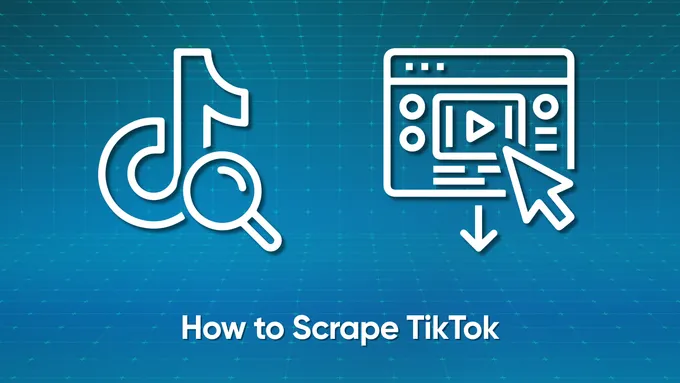How to Easily Copy Data from Any Shopify Store to Your Own
Shopify is a popular e-commerce platform that empowers entrepreneurs to create and manage online stores without coding. With Shopify, you can set up a website, manage products, track orders, process payments, and integrate marketing tools. One common use case for Shopify is to start a dropshipping business, which allows you to sell products without holding any inventory.
In this article, we’ll explore a no-code solution to duplicate a Shopify store by copying products from one Shopify store to another. Using a web scraping tool, you can extract product data like titles, descriptions, images, prices, and even discount codes from an existing store and seamlessly import it into your own online store pages. This process eliminates the need for programming skills and complex technical setups, saving time and allowing you to focus on marketing and sales.
Understanding Shopify Data
Before we move on to the practical use of the data copying tool, it’s important to understand what kind of data can be exported from a Shopify store. Shopify stores a wealth of product-related data essential for running a successful online business. This includes:
- Product names. The exact names of products that customers see.
- Product descriptions. Full and short descriptions of products with key features.
- Images. Photos and graphics associated with each product.
- Categories and tags. Classification systems to better organize the assortment.
- Prices. The cost of the product and discount options.
- Inventory levels. Data on product availability.
- SKUs and item numbers. Product identifiers for accounting and logistics.
For dropshippers, exporting this data is particularly beneficial, as it enables them to efficiently replicate products from one Shopify store to another, ensuring they have access to the same inventory and pricing strategies as their competitors. This capability not only helps in creating a high-quality and attractive online store but also streamlines the process of managing multiple destination stores.
When choosing a data extraction tool or cloning app, ensure it can capture all this information accurately to guarantee a complete and precise copy, whether you’re cloning an entire Shopify store or working with a single live store.
Data Format and Compatibility
For a successful data transfer to your Shopify store, it’s essential to ensure the data format is compatible. Shopify uses the CSV (Comma-Separated Values) format for importing and exporting data. This format is easily readable by humans and software, streamlining the process of transferring information.
When scraping data from another store, the data must be in a format that Shopify can import directly. The scraping tool mentioned in this article automatically downloads the information in the correct format, making the process as straightforward as possible. You won’t need to worry about converting the data or adjusting its structure - everything will be ready for quick and easy import into your store. This method is particularly useful for efficiently replicating products across multiple destination stores.
Exporting Data from Another Shopify Store
We’ll use our Shopify no-code scraper to extract data from another store. This tool allows you to export CSV files containing product data, including discount codes, from any Shopify store in a format ready to be imported directly into your online store pages. This makes it easy to duplicate a Shopify store or efficiently manage multiple destination stores.
Choose a Shopify Store
Select a Shopify store from which you want to copy data. In this example, we’ve chosen a dropshipping store, but you can pick any Shopify store that meets your needs. The data extraction process works the same for all Shopify stores, so feel free to choose one that offers the products you’re looking to import.

Our scraping tool is designed to work with any Shopify store, providing an easy and fast way to extract the necessary data. Select a store with the products you want to copy, and our Shopify no-code scraper will take care of the rest.
Use the No-Code Shopify Scraper
Sign up or log in to HasData and navigate to the no-code scrapers section. Upon signing up, you’ll receive 1,000 free credits, allowing you to test the platform and export data for up to 1,000 products at no cost.
Find the Shopify scraper in the no-code scrapers section. This tool allows you to extract data from any Shopify store easily without requiring any coding knowledge. Just enter the URL of the store you want to scrape.
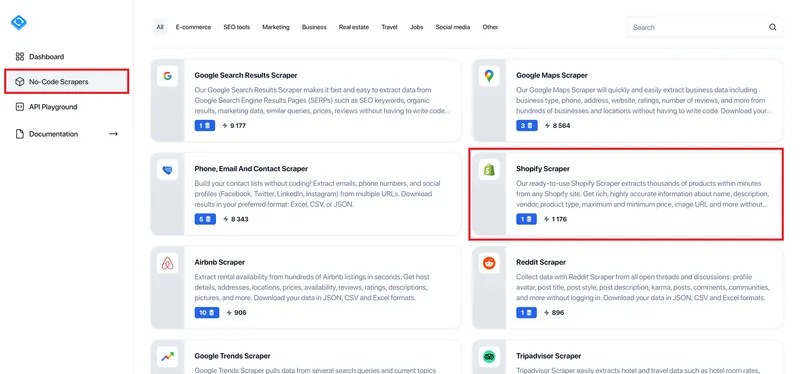
Next, provide the store link and select the desired currency for the product prices.
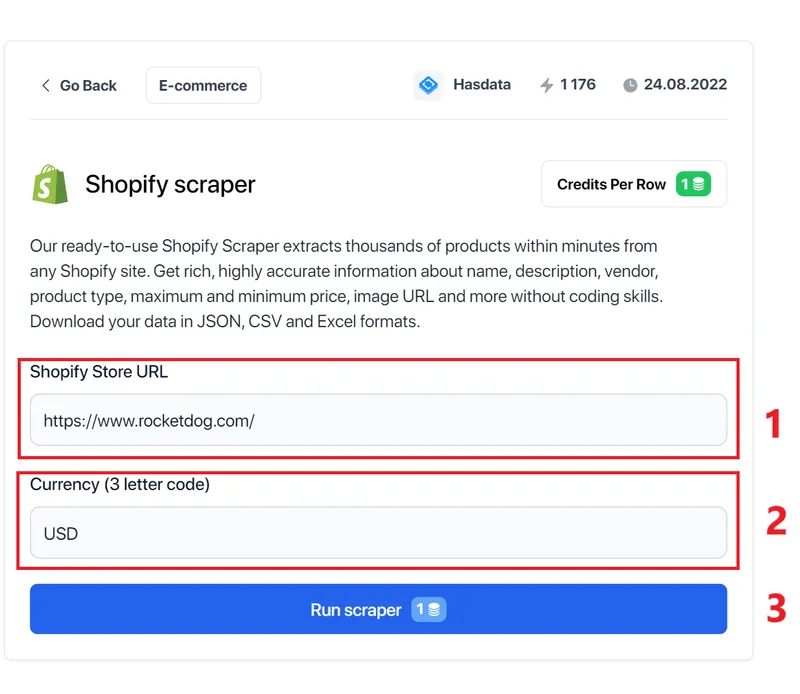
Finally, click the “Run Scraper” button and wait for the data extraction to complete.
Download Data
After collecting all the data using the scraper, click the download button and select the SHOPIFY format. This option automatically prepares the data in CSV format, optimized for quick import into your Shopify store.
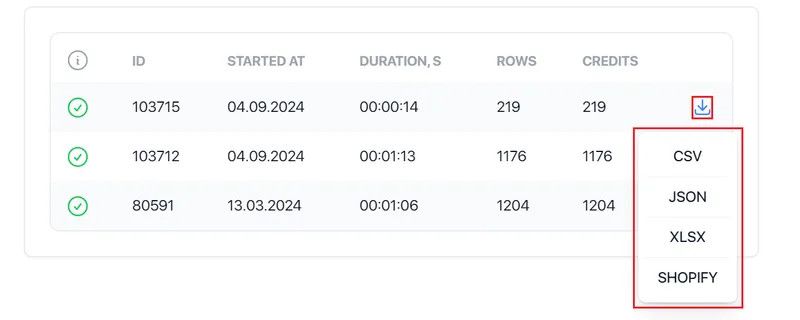
If you prefer to review or analyze the data first, you can download it in other available formats, such as CSV, JSON, or XLSX. These formats allow for easy data management and editing before you proceed with importing it into your store.
Importing Data into Your Own Shopify Store
Now that we’ve gathered and downloaded the data let’s import it into a new or existing Shopify store. To provide a clear and detailed demonstration, we’ll create a new store and guide you through each step of the process.
Prepare Your Own Shopify Store
To begin, visit the official Shopify website and click the ‘Sign Up’ button. If you already have an account and store, you can skip this step and move directly to importing products.
Before accessing your Shopify admin panel, you’ll be asked a few questions to tailor the platform to your needs. For example, you will be asked whether you’re new to e-commerce or already have an existing business.

Next, you’ll select a sales channel. Shopify offers several options, including an online store, social media platforms, and in-person sales. Choose based on how you plan to sell your products, as this will determine the features available in your store.
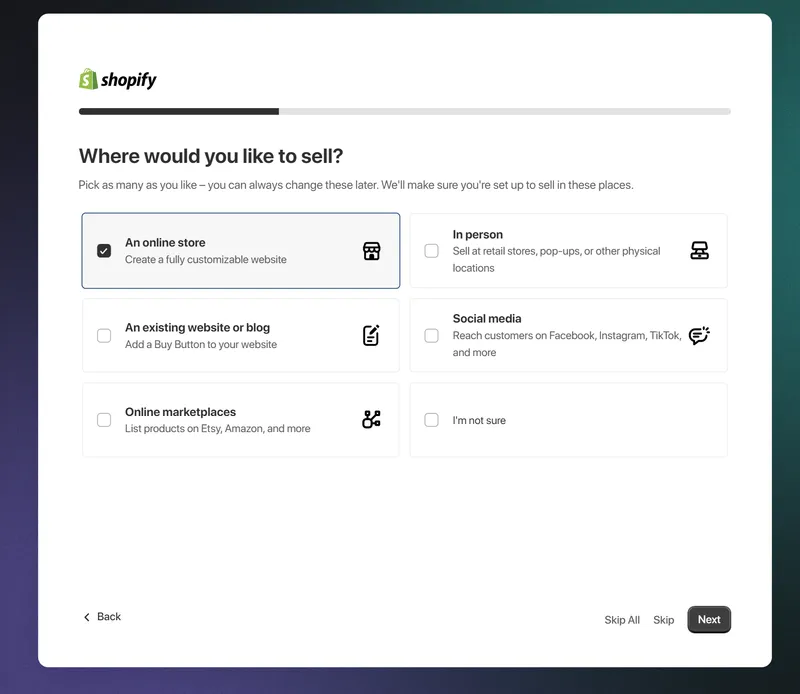
You’ll then choose the type of products you’re planning to sell. This helps Shopify provide relevant tools and recommendations. For instance, if you plan on dropshipping, select options supporting this business model.

Finally, select your country to set the appropriate language, currency, and region-specific store settings.

After completing the sign-up process, verify your email address or sign in using Google or another service. Once verified, your Shopify store creating process will be started.
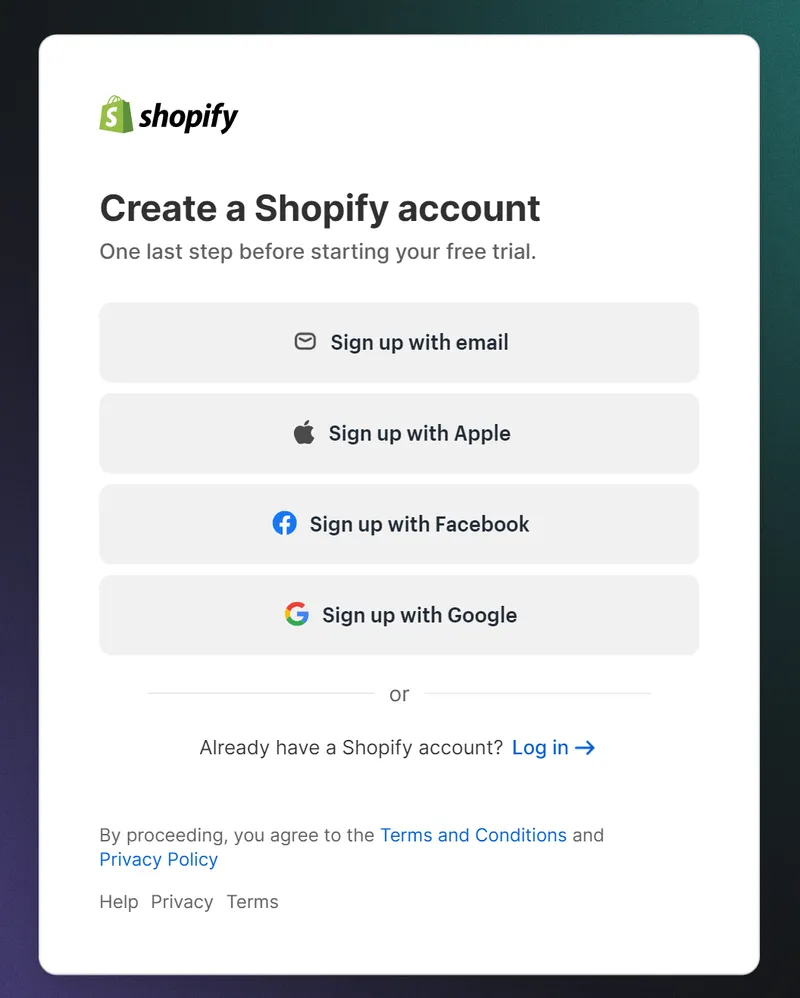
After completing the steps above, please allow a few minutes for the platform to generate your new store. This store will be pre-configured with features and settings tailored to your needs.
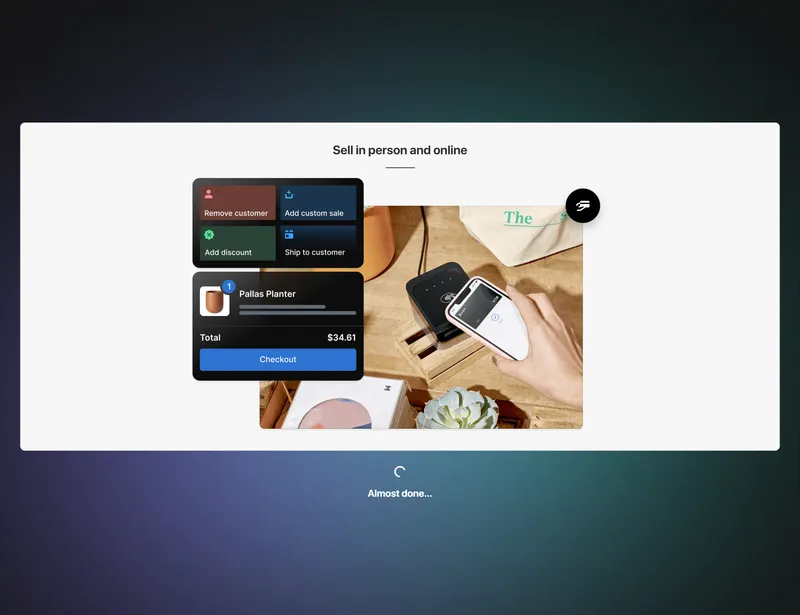
It’s important to note that, by default, your new store will not be publicly accessible. To make your store visible to customers, configure the public accessibility settings and connect it to a domain name.
Import Data into Existing Store
The last step in Shopify store cloning is to add the previously downloaded products to your online store. To do this, log in to the Shopify admin panel, navigate to the “Products” section, and click the “Import” button.
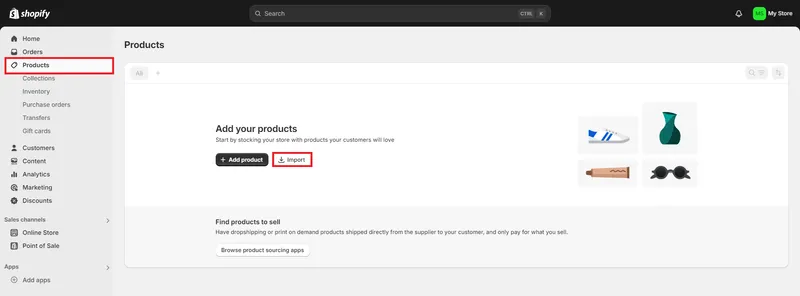
Next, drag and drop the previously downloaded CSV file, prepared in a format compatible with Shopify, and click on the “Upload and preview” button.

Shopify will automatically process the file and present a preview page where you can see essential information, including the number of products being uploaded, images, names, and other important details.

After reviewing and confirming the data, the import process will begin. You will receive a notification indicating that the product upload is in progress. At this point, you can either wait for the process to complete on the current page or close the window and continue working - the products will be added in the background.

Once the import process is complete, the products will appear in your catalog. On the “Products” page, you can view each product, make necessary changes, and update the information. If the upload was done in the background, the products may appear gradually, so be prepared for them not to be added all at once.
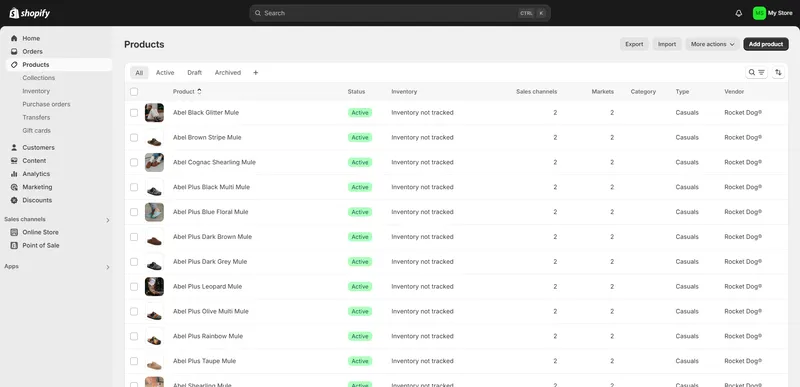
In the future, you can easily upload new products via import or add them manually. However, using a no-code scraper is a convenient and budget-friendly alternative to expensive automated solutions, allowing you to quickly expand your inventory without incurring additional costs.
Exporting Data from Amazon to Your Shopify Store
You can also use the no-code scraper to export data from Amazon to your Shopify store. This feature lets you directly import product information, including bestsellers and search results, into your Shopify catalog.
For example, to export all products from a search query, you can utilize the Amazon Search Scraper. Simply visit the page for our no-code scraper, specify the number of results for each keyword, enter your keywords, and provide the Amazon domain. Once you’ve set everything up, wait for the scraping process to complete, and then download the data in Shopify format. This method makes it easy to add a wide range of products to your store without manual effort.
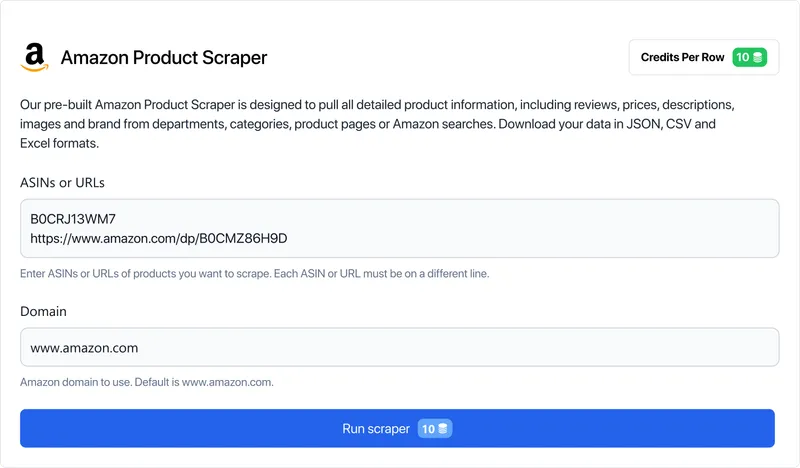
Similarly, you can also add information about specific products using our Amazon Product Scraper. With this tool, you can specify ASINs or URLs of particular items and obtain their data in a ready and convenient format for export to your Shopify store.
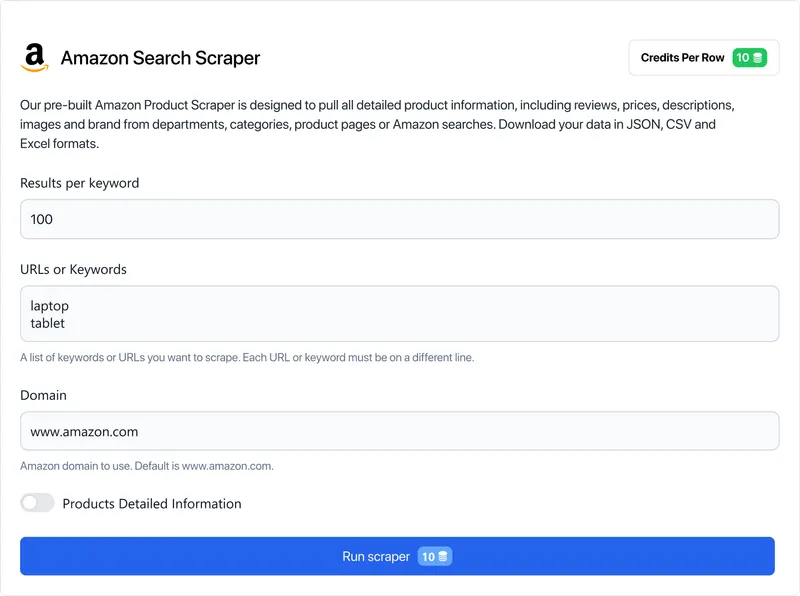
This flexibility allows you to curate a precise selection of products that best fit your business needs.
Conclusion and Takeaways
In this article, we aimed to provide a detailed guide on how to copy a Shopify store by quickly and easily transferring products from any Shopify store to your own. The method we discussed requires no programming skills or complex actions; it is intuitive and accessible to any user.
Transferring products from another store can be highly beneficial for dropshippers who share the same supplier and, consequently, the same products. By utilizing this approach, dropshippers can streamline their online store navigation and ensure consistency in their product offerings. Additionally, exporting product CSV files can help manage customer data and generate custom reports, providing valuable insights into sales trends and inventory levels. This method is also helpful if you want to transfer products from your own store, as much of this functionality on Shopify comes at a cost, especially when considering the need for a wholesale store or to duplicate a store across multiple destination stores.


